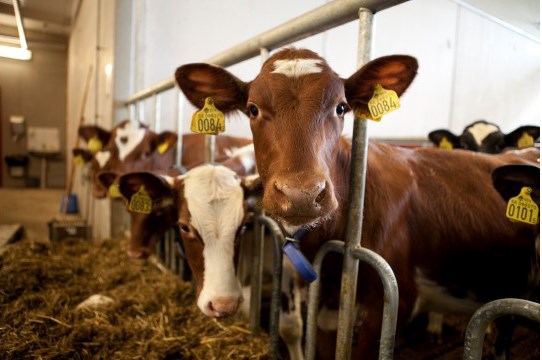In the Nordic project Feed Utilization in Nordic Cattle (FUNC) our aim is to improve feed efficiency (FE) by breeding, feeding and management. A proper definition of FE will be developed together with correlated proxy traits measurable in large scale at reasonable costs. New tools to consider FE for a more efficient milk production with reduced environmental impact will be developed for use in a sustainable dairy production.
The project has several part goals. The PhD student Bingjie Li studies genetic aspects of feed efficiency and related traits.
We found moderate heritability (0.2-0.4) for Dry matter intake (DMI) within the first 24 lactation weeks in primiparous Holstein, Nordic Red, and Jersey cows. The genetic variance for DMI might differ between breeds, but the difference was not significant in most of the periods studied due to large standard errors. Breed differences for genetic variances tended to be more obvious than for heritability. Genetic correlations for DMI were high in lactation weeks 5 to 24, whereas DMI in the first lactation period (lactation weeks 1 to 4) tended to be genetically different from DMI in subsequent lactation periods. The potential breed difference in genetic variation for DMI should be considered when using feed intake information from multiple breeds.
The second study aimed directly at the efficiency aspect and therefore include data with milk yield, live weight and body condition scores. We investigated the influence of cow lactation stage on the modeling of residual feed intake (RFI), and we also estimated genetic parameters for RFI in dairy cattle across lactation. When defining RFI, the effects of cows’ energy-corrected milk (ECM), metabolic body weight (BW), and change in BW on feed intake varied depending on lactation stages, especially in early lactation. Heritability of RFI ranged from 0.10 to 0.23 across lactation, and RFI was genetically different between early and later lactation stages. Neglect of lactation stage when defining RFI could affect the assessment of RFI and the estimation of genetic parameters of RFI across lactation.
In the third study the genetic heterogeneity of DMI, ECM, and BW across lactation was investigated in the three breeds, as well as the genetic correlations between DMI, ECM, and BW across lactation. The general patterns of genetic parameters for DMI, ECM, and BW across lactation were similar across dairy cattle breeds (Holstein, RDC, and Jersey). Feed intake is genetically not the same trait across lactation stages, especially not between early and later lactation. Measurement of feed intake is recommended to be spread over different lactation stages from the entire lactation, or at least recorded from both early and middle lactation. Compared with feed intake, ECM and BW showed much less genetic heterogeneity across lactation in all the three breeds. The genetic correlations between DMI, ECM, and BW changed across lactation, but the patterns of the change in genetic correlations between DMI, ECM, and BW were very similar between breeds.
